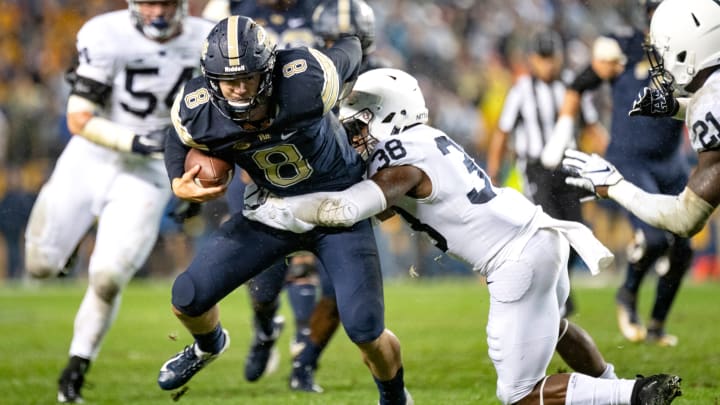Ahead of 100th Meeting, Is the Penn State–Pitt Rivalry at Risk of Fading Away?

In the past decade, plenty of college rivalries have gone by the wayside as a result of conference realignment: Texas–Texas A&M, Missouri-Kansas, Pitt–West Virginia, to name a few. Others have been interrupted, with talks akin to peace deals needed to negotiate even temporary resumption.
Penn State–Pitt, which will kick off Saturday at 12:00 ET, falls in the latter category for now—but it was also a victim of conference machinations long before realignment kicked off in earnest in 2010. You see, until the 1990s, both schools played as independents; Pitt joined the Big East in 1991, Penn State the Big Ten in ’93. Prior to making those allegiances, though, Penn State coach Joe Paterno had tried to create something he called the “Eastern Conference” in 1981, which would have aligned a group of teams with geographical proximity and natural rivalries. It never came together, and as soon as Pitt joined forces with the Big East, the rivalry was on shaky ground.
It’s been there since, essentially, and Saturday’s game, which is the 100th meeting between these two teams, is the last of this rivalry on the schedule. As of now, Pitt has said it would be open to playing in 2026, but Penn State athletics director Sandy Barbour countered that the Nittany Lions’ next open date in which the game could be played won’t come until 2030.
“We’re open to having discussions,” Penn State coach Franklin said at his weekly press conference Tuesday. “But it’s got to equally make sense for both parties. It’s got to make sense for Pitt. It’s got to make sense for Penn State.”
Pat Narduzzi, Pitt’s coach, had a slightly less optimistic take on the significance of Saturday’s game: “It’s another game for us, but it’s a big game because it’s a rivalry game, in-state,” he said at his weekly news conference. “I’m going to emphasize this to our kids, you might be the last team to ever get to play this game. It might be. I don’t know if it’ll be played [again],” he said Monday. “I’m either going to be in a coffin or retired probably, so I don’t know which one it’ll be.”
From 2000–15, the teams didn’t play, and that break was the longest in the rivalry’s history. It’s impossible to say if this standoff will last even longer, and even if the teams do meet in 2030, that would still constitute the second-longest hiatus the rivalry has gone through. The teams took two years off after their first matchup in 1893, three seasons off from 1897–99 and another three-year break from 1932–34. The game was played continuously from 1935–92, but once conferences entered the picture, it became increasingly sporadic, and the rivalry has been played only in two four-year spurts: from 1997–2000 and again from 2016–19.
What’s worse, this back-and-forth or the obstinacy that has derailed other rivalries from picking back up? That’s impossible to say, but there’s something especially frustrating about this one. In the case of, say, Missouri and Kansas, one school has been a vocal proponent that it won’t play the other. Here, though, it’s wishy-washy, bureaucratic. At least when one school stamps its collective foot and says no, that keeps a level of animosity alive. This feels more like a game of phone tag, a “my people will get in touch with your people, and let’s compare calendars on our Palm Pilots” situation.
In the meantime, though, both schools have plenty to get fired up about, and not just because Narduzzi thinks he might be six feet under before the rivalry is resumed. A decade-or-longer break will leave this game stamped in fans’ memories, and Penn State comes in the heavy favorite, ranked No. 13 and having generated big offensive numbers thus far. Sophomore quarterback Sean Clifford has started hot for the Nittany Lions, completing 66.7% of his passes for 559 yards and six touchdowns. He hasn’t thrown an interception. Meanwhile, Pitt has seen solid defensive performances, limiting opponents to an average of 261.0 yards per game (No. 24 in the FBS); the Panthers have been most effective against the run and allowed Ohio just 35 yards on the ground last week.
Going into Saturday’s game, Penn State has the edge all-time, with 52 wins over Pitt. The Panthers have won 43 times, and four games in the rivalry series have ended in ties. Penn State has won the game in each of the past two seasons, last year in a 51–6 blowout, and Pitt won in 2016, 42–39.
